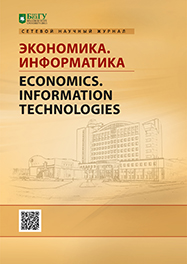A REVIEW OF MATHEMATIC MODELING METHODS OF GENETIC CODE PROPERTIES
DOI:
https://doi.org/10.18413/2687-0932-2020-47-2-372-379Keywords:
genetic code, gene mapping, point mutations, modeling, overlapping genesAbstract
The paper gives brief analysis of the developed statistical models studying the properties of the genetic code. Authors generate the codes, called theoretical genetic codes having the same properties as trivial genetic code. The main idea of the analyzed mathematical models is to find the optimal code from theoretical genetic codes. Based on the following criterias of amino acids: hydrophilic properties, isoelectric properties, affinity to water and molecular mass authors compare the theoretical genetic codes to the trivial geneic code. They also used the extra criterion – transition or transvertion, meaning the nature of point mutation. The retrospect of the key elements of these approaches to modeling is given. The subject of modeling in the studied methods is gene mapping that play an important role in the study of differences in individual genomes. Prediction of the properties of theoretical codes and the creation of new approaches to their models will allow us to come closer to understanding the structure of the genetic code.
Downloads
References
Балабанова Т.Н., Трапезникова И.В. 2018. Синтез панорамных изображений и их
использование в цитогенетических исследованиях. Научные ведомости БелГУ, 45: 760–768.
Петухов С.В. 2008. Матричная генетика, алгебры генетического кода, помехоустойчивость.
М.; Ижевск: Регулярная и хаотическая динамика, 316 с.
Ahmad, M., Jung, L., and Bhuiyan A. 2017. From DNA to protein: Why genetic code context of
nucleotides for DNA signal processing? Biomedical Signal Processing and Control, 34: 44–63.
Alff-Steinberger, C. 1969. The genetic code and error transmission. Natl. Acad. Sci. USA,
: 584–591.
Amirnovin, R. 1997. An analisys of the metabolic theory of the origin of the genetic code. J Mol
Evol, 44: 473–476.
Ardell D.H. 1998. On error minimization in a sequential origin of the standard genetic code. Journal
of molecular evolution, 47: 1–13.
Cairns, J., Overbaugh, J. and Miller, S. 1998. The origin of mutants. Nature (London),
: 142–145.
Crick, FHC. 1968. The origin of the genetic code. J Mol Biol., 38: 367–379.
Crick, FHC., et al. 1976. A speculation on the origin of protein synthesis. Orig. Life., 7: 389–397.
Epstein, CJ. 1966. Role of the amino-acid “code” and of selection for conformation in the evolution of proteins. Nature, 210: 25–28.
Freeland S.J., Hurst L.D. 1998. The genetic code is one in a million. Journal of molecular evolution, 47: 238–248.
Forger M., Sachse S. 2000. Lie superalgebras and the multiplet structure of the genetic code. I. Codon representations. Journal of Mathematical Physics, 41: 5407–5422.
Gamow G., Rich A., Yčas M. 1956. The problem of information transfer from the nucleic acids to proteins. Advances in biological and medical physics. – Elsevier, 4: 23–68.
Gamow, G. 1954. Possible mathematical relation between deoxybonucleic acid and proteins. Det Kongelige Danske Videnskabernes. Biologiske Meddelelser, 22:1–13.
Gilis D. et al. 2001. Optimality of the genetic code with respect to protein stability and amino-acid frequencies. Genome biology, 2: research0049. 1
Giulio, MD. 1997. On the origin of the genetic code. J. Theor. Biol., 187: 573–581.
Giulio, D. 2013. The origin of the genetic code in the ocean abysses: New comparisons confirm old observations. Journal of Theoretical Biology, 333: 109–116.
Goldman N. 1993. Further results on error minimization in the genetic code. Journal of molecular evolution, 37: 662–664.
Gumbel M. et al. 2015. On models of the genetic code generated by binary dichotomic algorithms. Biosystems, 128: 9–18.
Haig, D., and Hurst, LD. 1991. A quantitative measure of error minimization in the genetic code. J. Mol Evol., 33: 412– 417.
Knight R.D., Freeland S.J., Landweber L.F. 1999. Selection, history and chemistry: the three faces of the genetic code. Trends in biochemical sciences, 24: 241–247.
Kuruoglu E.E., Arndt P.F. 2017. The information capacity of the genetic code: Is the natural code optimal? Journal of theoretical biology, 419: 227–237.
Lenstra R. 2014. Evolution of the genetic code through progressive symmetry breaking. Journal of theoretical biology, 347: 95–108.
Lin K., May A. C. W., Taylor W. R. 2001. Amino acid substitution matrices from an artificial neural network model. Journal of Computational Biology, 8: 471–481.
Nemzer L.R. 2017. A binary representation of the genetic code. Biosystems, 155: 10–19.
Pelc S.R. 1965. Correlation between coding-triplets and amino-acids. Nature, 207: 597–599.
Rodin A.S., Branciamore S. 2013. The Universal Genetic Code and Non-Canonical Variants. Brenner's Encyclopedia of Genetics, 263–264.
Trenchev I. et al. 2017. Mathematical Models for Studying the Properties of the Genetic Code. Der Pharmacia Lettre, 9 [8]: 40–54.
Abstract views: 882


